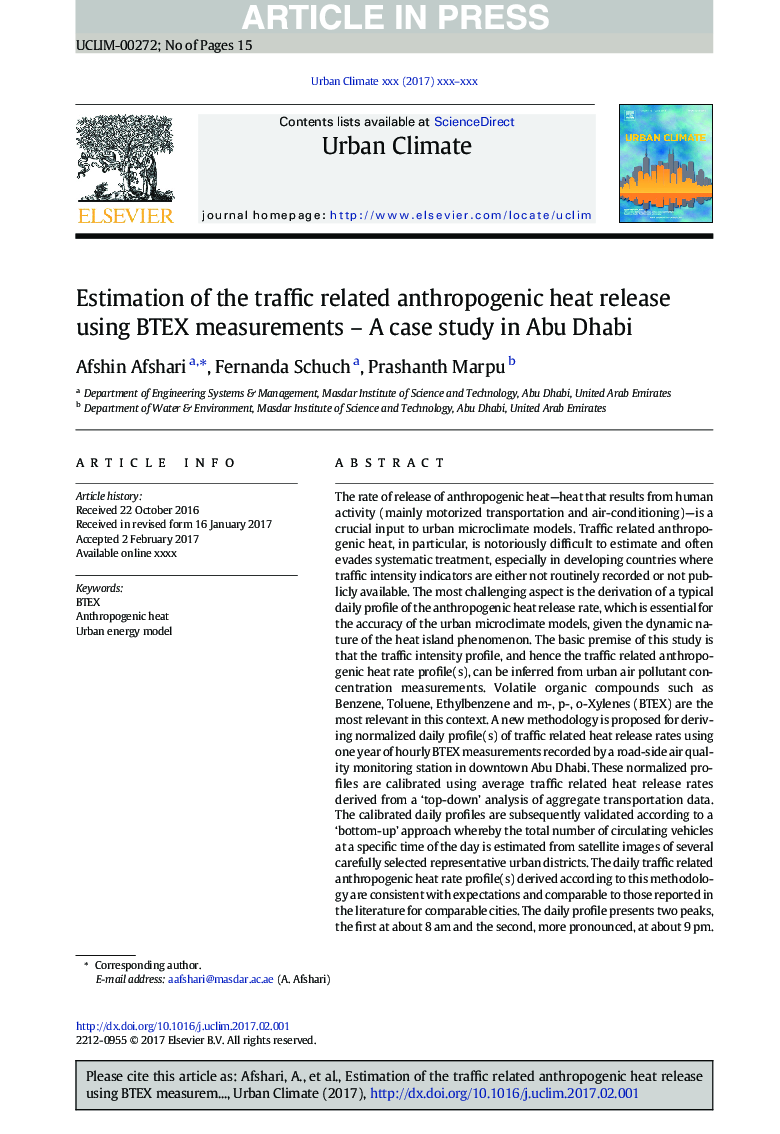| کد مقاله | کد نشریه | سال انتشار | مقاله انگلیسی | نسخه تمام متن |
|---|---|---|---|---|
| 6576873 | 1422839 | 2018 | 15 صفحه PDF | دانلود رایگان |
عنوان انگلیسی مقاله ISI
Estimation of the traffic related anthropogenic heat release using BTEX measurements - A case study in Abu Dhabi
دانلود مقاله + سفارش ترجمه
دانلود مقاله ISI انگلیسی
رایگان برای ایرانیان
کلمات کلیدی
موضوعات مرتبط
مهندسی و علوم پایه
علوم زمین و سیارات
علوم زمین و سیاره ای (عمومی)
پیش نمایش صفحه اول مقاله

چکیده انگلیسی
The rate of release of anthropogenic heat-heat that results from human activity (mainly motorized transportation and air-conditioning)-is a crucial input to urban microclimate models. Traffic related anthropogenic heat, in particular, is notoriously difficult to estimate and often evades systematic treatment, especially in developing countries where traffic intensity indicators are either not routinely recorded or not publicly available. The most challenging aspect is the derivation of a typical daily profile of the anthropogenic heat release rate, which is essential for the accuracy of the urban microclimate models, given the dynamic nature of the heat island phenomenon. The basic premise of this study is that the traffic intensity profile, and hence the traffic related anthropogenic heat rate profile(s), can be inferred from urban air pollutant concentration measurements. Volatile organic compounds such as Benzene, Toluene, Ethylbenzene and m-, p-, o-Xylenes (BTEX) are the most relevant in this context. A new methodology is proposed for deriving normalized daily profile(s) of traffic related heat release rates using one year of hourly BTEX measurements recorded by a road-side air quality monitoring station in downtown Abu Dhabi. These normalized profiles are calibrated using average traffic related heat release rates derived from a 'top-down' analysis of aggregate transportation data. The calibrated daily profiles are subsequently validated according to a 'bottom-up' approach whereby the total number of circulating vehicles at a specific time of the day is estimated from satellite images of several carefully selected representative urban districts. The daily traffic related anthropogenic heat rate profile(s) derived according to this methodology are consistent with expectations and comparable to those reported in the literature for comparable cities. The daily profile presents two peaks, the first at about 8Â am and the second, more pronounced, at about 9Â pm. The average workday sensible heat release rate is estimated to be 11.4Â W/m2 with an evening peak of about 19Â W/m2. The peak latent heat rate is approximately 1.9Â W/m2 which amounts to about 10% of the sensible rate.
ناشر
Database: Elsevier - ScienceDirect (ساینس دایرکت)
Journal: Urban Climate - Volume 24, June 2018, Pages 311-325
Journal: Urban Climate - Volume 24, June 2018, Pages 311-325
نویسندگان
Afshin Afshari, Fernanda Schuch, Prashanth Marpu,